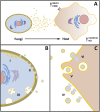Traveling into Outer Space: Unanswered Questions about Fungal Extracellular Vesicles
- PMID: 26633018
- PMCID: PMC4669077
- DOI: 10.1371/journal.ppat.1005240
Traveling into Outer Space: Unanswered Questions about Fungal Extracellular Vesicles
Conflict of interest statement
The authors have declared that no competing interests exist.
Figures

References
-
- Albuquerque PC, Nakayasu ES, Rodrigues ML, Frases S, Casadevall A, et al. (2008) Vesicular transport in Histoplasma capsulatum: an effective mechanism for trans-cell wall transfer of proteins and lipids in ascomycetes. Cell Microbiol 10: 1695–1710. 10.1111/j.1462-5822.2008.01160.x - DOI - PMC - PubMed
Publication types
MeSH terms
Substances
Grants and funding
LinkOut - more resources
Full Text Sources
Other Literature Sources
Medical

